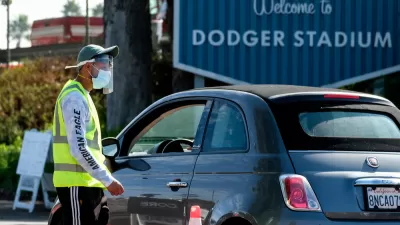Harvard University's Global Health Insititute and Edmond J. Safra Center for Ethics have launched a new online tool for planners, policy makers, and the public to determine the severity of the coronavirus outbreak in one's county and state.

"The public needs clear and consistent information about COVID risk levels in different jurisdictions for personal decision-making, and policy-makers need clear and consistent visibility that permits differentiating policy across jurisdictions," explains Danielle Allen, director of the Edmond J. Safra Center for Ethics at Harvard University. “We also collectively need to keep focused on what should be our main target: a path to near zero case incidence.”
"A path to zero" should have resonance with Planetizen readers familiar with mitigation strategies to reduce greenhouse gas emissions to fight climate change. Harvard has applied the terminology to the pandemic – coronavirus case incidence, as measured in new cases determined by diagnostic testing, per 100,000 people, using a seven day rolling average, needs to be reduced as much as possible to suppress COVID-19.
The new "zero" or "near zero" is appropriately colored green that communities should strive for in order to reduce the risk of infection to the greatest extent possible.
The new framework brings clarity to metrics that help communities determine the severity of the outbreak they are responding to. A new COVID Risk Level map shows if a county or state is on the green, yellow, orange or red risk level, based on the number of new daily cases. The framework then delivers broad guidance on the intensity of control efforts needed based on these COVID risk levels. It offers key performance indicators for testing and contact tracing across all risk levels, as a backbone for suppression efforts.
To familiarize yourself with the purpose and function of the risk map, I recommend a 3-minute listen to NPR's introduction to the new tool which was unveiled on July 1 by a "convergence group" that includes the Rockefeller Foundation, CovidActNow, Covid-Local, and the Center for Infectious Disease Research and Policy at the University of Minnesota.
Allison Aubrey and Carmel Wroth, correspondents for NPR News, write:
For the public, this means you can now compare the case incidence where you live to that of, say, a nearby county where you're considering going on an errand. Or the county where your parents live if you're considering a visit. It gives you a way to assess your community's risk level compared to others, at a glance, and modify your behavior accordingly.
For policy-makers, the risk levels are meant to signal the intensity of the effort needed to control COVID-19 and to trigger specific interventions. The collaborative released guidance for how state and local leaders should manage their response, depending on their risk level.
An example
Checking on my county and state on July 27, I see that San Mateo, California, is at orange level (as is the entire Bay Area) with 10.4 new daily new cases per 100k people (7-day moving average), while neighboring Santa Cruz County is yellow, with 6.6 daily new cases. Only Alpine, Sierra, and Modoc counties, the three least-populated in the state, are green, on the path to containment.
"At orange levels, community spread has accelerated and is at dangerous levels," states the framework document, "Key Metrics for COVID Suppression" [pdf]. Stay- at-home orders are advised, unless viral testing and contact tracing capacity are implementable at levels meeting surge indicator standards," are indicated under "Intensity of Control Effort Needed" in the color-coded table on top of page 3 of for orange level counties.
Two other metrics, in addition to diagnostic testing, are used to determine case incidence:
- "Metric 2: Case trend as an estimate from new deaths trend: New daily deaths per 100k pop * 100 (assuming 1% [infection fatality rate] IFR) (seven day rolling average); + trend direction and rate
- "Metric 3: New daily hospitalizations per 100k pop (seven day rolling average); + trend direction and rate"
Finally, Danielle Allen was featured in the July 1 Politico Magazine. In some ways, she sounds a bit like Anthony Fauci, the nation's top epidemiologist, in a recent post. "If you think the coronavirus pandemic is simply a health crisis, or a crisis of leadership in Washington, it’s time to wake up," writes Zack Stanton.
This moment is nothing less than an “existential crisis” that will reshape American society, says Danielle Allen, head of Harvard’s Safra Center for Ethics and co-author of the university’s “Roadmap to Pandemic Resilience [pdf].” “It is a moment where societies are forced to answer the question of who they are. And I think [the U.S.] didn’t answer that question terribly well."
Related in Planetizen:
- U.S. Needs to More Than Triple Testing Before States Can Open, Study Says, April 20, 2020
-
Blog post: How City Planning Can Affect How Diseases Spread, June 10, 2018
-
The 1854 Map That Transformed Public Health in Urban Areas, November 11, 2017

Trump Administration Could Effectively End Housing Voucher Program
Federal officials are eyeing major cuts to the Section 8 program that helps millions of low-income households pay rent.

Planetizen Federal Action Tracker
A weekly monitor of how Trump’s orders and actions are impacting planners and planning in America.

Ken Jennings Launches Transit Web Series
The Jeopardy champ wants you to ride public transit.

Washington Legislature Passes Rent Increase Cap
A bill that caps rent increases at 7 percent plus inflation is headed to the governor’s desk.

From Planning to Action: How LA County Is Rethinking Climate Resilience
Chief Sustainability Officer Rita Kampalath outlines the County’s shift from planning to implementation in its climate resilience efforts, emphasizing cross-departmental coordination, updated recovery strategies, and the need for flexible funding.

New Mexico Aging Department Commits to Helping Seniors Age ‘In Place’ and ‘Autonomously’ in New Draft Plan
As New Mexico’s population of seniors continues to grow, the state’s aging department is proposing expanded initiatives to help seniors maintain their autonomy while also supporting family caregivers.
Urban Design for Planners 1: Software Tools
This six-course series explores essential urban design concepts using open source software and equips planners with the tools they need to participate fully in the urban design process.
Planning for Universal Design
Learn the tools for implementing Universal Design in planning regulations.
Heyer Gruel & Associates PA
Ada County Highway District
Institute for Housing and Urban Development Studies (IHS)
City of Grandview
Harvard GSD Executive Education
Toledo-Lucas County Plan Commissions
Salt Lake City
NYU Wagner Graduate School of Public Service





























